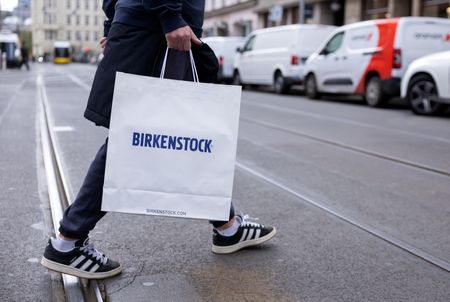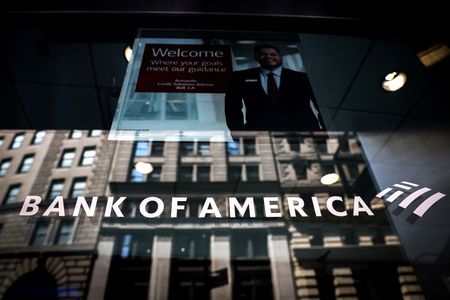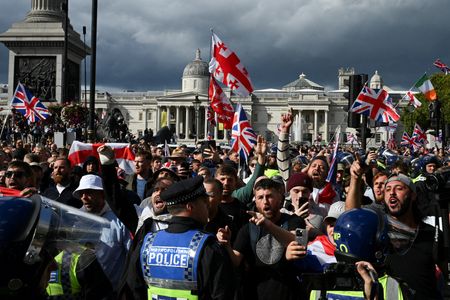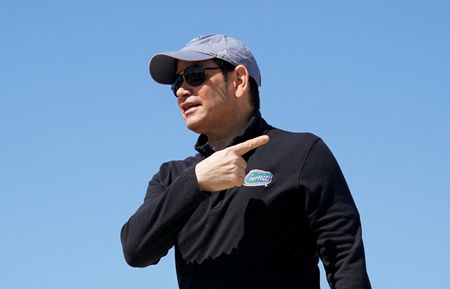By Helen Reid and Francesco Canepa
LONDON/FRANKFURT (Reuters) -Global retailers including sandal maker Birkenstock and jeweller Pandora are looking at spreading the cost of U.S. tariffs by raising prices across markets to avoid big hikes in the United States that could hurt sales.
A global presence gives large retailers an advantage to minimise higher tariff costs in the U.S. But it is putting central banks on watch as the strategy could fuel inflation in other markets like the European Union and Britain, where consumer prices have finally started to stabilise.
Birkenstock’s chief financial officer said last week that a “low-single-digit” price increase globally would be enough to offset the U.S. tariff impact.
Pandora CEO Alexander Lacik said the Danish company is debating whether to raise prices globally or more in the U.S., its biggest market.
“Companies are really thinking about distributing the tariff,” said Markus Goller, partner at consultancy Simon Kucher in Bonn, Germany. “A manufacturer from outside of the U.S. might say, OK, I cannot increase my prices to the U.S. market that much, so I will do a little increase in the U.S., and a little increase in Europe, and in other markets.”
U.S. President Donald Trump has imposed a blanket tariff of 10% on all global imports and is threatening higher so-called “reciprocal” tariffs on its trading partners.
When U.S. behemoth Walmart said it would have to raise prices in response to tariffs, Trump ordered the world’s biggest retailer via social media to ‘eat the tariffs’.
Announcing price increases in non-U.S. markets could be a way for retailers to avoid a similar backlash from Trump.
“Obviously if your products coming into the U.S. are now subject to tariffs, then math says that you have to raise your prices in the U.S.,” said Jean-Pierre Dubé, professor of marketing at the University of Chicago Booth School of Business.
“But you don’t want to be accused by the White House of raising prices purely because of U.S. tariffs, so if you can demonstrate that your prices are going up everywhere then… it’s kind of a shield.”
Retailers could raise prices on certain products or in certain markets where consumers are less price-sensitive, and use that to subsidise other products or countries where price hikes would hurt sales more, said Jason Miller, professor of supply chain management at Michigan State University.
“Maybe a U.S.-only firm has to raise (U.S.) prices by 12%. But you, as a global firm, raise prices by 8% because you can play with pricing in other markets,” he said.
If many multinational retailers do spread the tariff pain, higher inflation could spread even to countries which, like Britain, have already struck trade agreements with the U.S. in a bid to minimise the economic fallout of tariffs.
Bank of England Governor Andrew Bailey earlier this month raised the issue of “global companies that don’t make that distinction [on tariff rates] and just say, we’re going to impose a pricing solution which goes right across the world irrespective of those differences.”
“I think we do have to watch that carefully,” he said.
INFLATION UNCERTAINTY
In the euro zone, inflation was finally gliding towards the European Central Bank’s 2% target. European companies surveyed by the European Central Bank (ECB) in late March said price growth in the retail sector was subdued.
But that was before Trump unveiled his tariff policy on April 2, and later hiked tariffs on Chinese goods to 145%.
However, the U.S. tariffs on China – lowered last week to 30% – have allowed some European retailers to source goods more cheaply than before.
Martino Pessina, CEO of Takko Fashion, which sells clothes in 17 European countries, said suppliers in China had offered lower prices as U.S. retailers cancelled orders from factories there, and shipping costs also fell.
“What we don’t know is if there’s going to be inflation in the U.S. and if that inflation comes to Europe or not,” Pessina said.
Some big retailers have in any case ruled out raising prices outside the U.S..
“There is no reason to raise prices outside the U.S. because of the tariffs,” Adidas CEO Bjorn Gulden told investors after reporting results late last month. “The discussion we’re having on tariffs is only for the U.S..”
ECB executive board member Isabel Schnabel has said the euro zone’s inflation rate may initially dip below the central bank’s 2% target, but that tariffs might prove inflationary further down the road.
“In order to compensate for the hit to input costs, firms also tend to raise the prices of goods not directly affected by tariffs,” Schnabel said in a speech earlier this month.
While every company has its own pricing strategy, economists warn some could take advantage of tariffs to raise prices by more than rising costs, boosting their profits similarly to the inflation surge of 2021-2022 during the pandemic.
“It will be very difficult for a firm’s customers to know what portion of the product’s total costs are subject to the tariff, or even the tariff rate that applies. This information asymmetry creates a ripe environment for exploitation. Just as it did during COVID,” said Hal Singer, professor of economics at the University of Utah.
U.S. consumers’ 12-month inflation expectations jumped in April to 6.7%, the highest reading since 1981. And in the euro zone, too, consumers are expecting inflation to rise.
“If people are expecting inflation, well then it gives firms a little bit more room to raise prices,” said Miller.
(Reporting by Helen Reid and Francesco Canepa, Additional reporting by Balazs Koranyi; Editing by Lisa Jucca and Susan Fenton)











